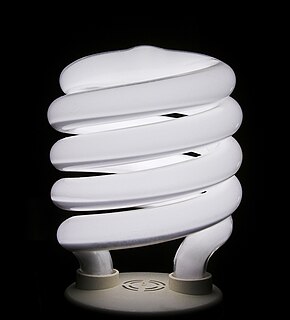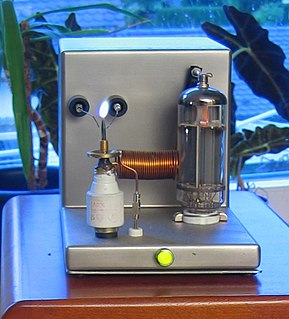This article needs additional citations for verification .(January 2021) (Learn how and when to remove this template message) |
A discharge ionization detector (DID) is a type of detector used in gas chromatography.
This article needs additional citations for verification .(January 2021) (Learn how and when to remove this template message) |
A discharge ionization detector (DID) is a type of detector used in gas chromatography.
A DID is an ion detector which uses a high-voltage electric discharge to produce ions. The detector uses an electrical discharge in helium to generate high energy UV photons and metastable helium which ionizes all compounds except helium. [1] The ions produce an electric current, which is the signal output of the detector. The greater the concentration of the component, the more ions are produced, and the greater the current.
DIDs are sensitive to a broad range of components. In Air Separation plants they are used to detect the components CO; CH2; C+; N2; O2 in Argon product in ppm range.
DIDs are non-destructive detectors. They do not destroy/consume the components they detect. Therefore, they can be used before other detectors in multiple-detector configurations.
DIDs are an improvement over Helium ionization detectors in that they contain no radioactive source.

A Geiger counter is an instrument used for detecting and measuring ionizing radiation. Also known as a Geiger–Muller counter, it is widely used in applications such as radiation dosimetry, radiological protection, experimental physics, and the nuclear industry.

The Geiger–Müller tube or G–M tube is the sensing element of the Geiger counter instrument used for the detection of ionizing radiation. It was named after Hans Geiger, who invented the principle in 1908, and Walther Müller, who collaborated with Geiger in developing the technique further in 1928 to produce a practical tube that could detect a number of different radiation types.
Mass spectrometry (MS) is an analytical technique that is used to measure the mass-to-charge ratio of ions. The results are typically presented as a mass spectrum, a plot of intensity as a function of the mass-to-charge ratio. Mass spectrometry is used in many different fields and is applied to pure samples as well as complex mixtures.

A gas-filled tube, also known as a discharge tube, is an arrangement of electrodes in a gas within an insulating, temperature-resistant envelope. Gas-filled tubes exploit phenomena related to electric discharge in gases, and operate by ionizing the gas with an applied voltage sufficient to cause electrical conduction by the underlying phenomena of the Townsend discharge. A gas-discharge lamp is an electric light using a gas-filled tube; these include fluorescent lamps, metal-halide lamps, sodium-vapor lamps, and neon lights. Specialized gas-filled tubes such as krytrons, thyratrons, and ignitrons are used as switching devices in electric devices.

Gas chromatography (GC) is a common type of chromatography used in analytical chemistry for separating and analyzing compounds that can be vaporized without decomposition. Typical uses of GC include testing the purity of a particular substance, or separating the different components of a mixture. In some situations, GC may help in identifying a compound. In preparative chromatography, GC can be used to prepare pure compounds from a mixture.

A glow discharge is a plasma formed by the passage of electric current through a gas. It is often created by applying a voltage between two electrodes in a glass tube containing a low-pressure gas. When the voltage exceeds a value called the striking voltage, the gas ionization becomes self-sustaining, and the tube glows with a colored light. The color depends on the gas used.

The proportional counter is a type of gaseous ionization detector device used to measure particles of ionizing radiation. The key feature is its ability to measure the energy of incident radiation, by producing a detector output pulse that is proportional to the radiation energy absorbed by the detector due to an ionizing event; hence the detector's name. It is widely used where energy levels of incident radiation must be known, such as in the discrimination between alpha and beta particles, or accurate measurement of X-ray radiation dose.
The ionization chamber is the simplest of all gas-filled radiation detectors, and is widely used for the detection and measurement of certain types of ionizing radiation; X-rays, gamma rays, and beta particles. Conventionally, the term "ionization chamber" is used exclusively to describe those detectors which collect all the charges created by direct ionization within the gas through the application of an electric field. It only uses the discrete charges created by each interaction between the incident radiation and the gas, and does not involve the gas multiplication mechanisms used by other radiation instruments, such as the Geiger counter or the proportional counter.
![Chemical ionization Ionization technique used in mass [[spectroscopy]]](https://upload.wikimedia.org/wikipedia/commons/thumb/7/7b/Chemical_Ionization.png/320px-Chemical_Ionization.png)
Chemical ionization (CI) is a soft ionization technique used in mass spectrometry. This was first introduced by Burnaby Munson and Frank H. Field in 1966. This technique is a branch of gaseous ion-molecule chemistry. Reagent gas molecules are ionized by electron ionization, which subsequently react with analyte molecules in the gas phase in order to achieve ionization. Negative chemical ionization (NCI), charge-exchange chemical ionization and atmospheric-pressure chemical ionization (APCI) are some of the common variations of this technique. CI has several important applications in identification, structure elucidation and quantitation of organic compounds. Beside the applications in analytical chemistry, the usefulness in chemical ionization extends toward biochemical, biological and medicinal fields as well.

Gaseous ionization detectors are radiation detection instruments used in particle physics to detect the presence of ionizing particles, and in radiation protection applications to measure ionizing radiation.

Ion-mobility spectrometry (IMS) is an analytical technique used to separate and identify ionized molecules in the gas phase based on their mobility in a carrier buffer gas. Though heavily employed for military or security purposes, such as detecting drugs and explosives, the technique also has many laboratory analytical applications, including the analysis of both small and large biomolecules. IMS instruments are extremely sensitive stand-alone devices, but are often coupled with mass spectrometry, gas chromatography or high-performance liquid chromatography in order to achieve a multi-dimensional separation. They come in various sizes, ranging from a few millimeters to several meters depending on the specific application, and are capable of operating under a broad range of conditions. IMS instruments such as microscale high-field asymmetric-waveform ion-mobility spectrometry can be palm-portable for use in a range of applications including volatile organic compound (VOC) monitoring, biological sample analysis, medical diagnosis and food quality monitoring. Systems operated at higher pressure are often accompanied by elevated temperature, while lower pressure systems (1-20 hPa) do not require heating.

A flame ionization detector (FID) is a scientific instrument that measures analytes in a gas stream. It is frequently used as a detector in gas chromatography. The measurement of ion per unit time make this a mass sensitive instrument. Standalone FIDs can also be used in applications such as landfill gas monitoring, fugitive emissions monitoring and internal combustion engine emissions measurement in stationary or portable instruments.
A photoionization detector or PID is a type of gas detector.
Many gas chromatograph detectors are ion detectors with varying methods of ionizing the components eluting from the gas chromatograph's column.
A helium ionization detector (HID) is a type of detector used in gas chromatography.

Plasma speakers or ionophones are a form of loudspeaker which varies air pressure via a high-energy electrical plasma instead of a solid diaphragm. Connected to the output of an audio amplifier, plasma speakers vary the size of a plasma glow discharge, corona discharge or electric arc which then acts as a massless radiating element, creating the compression waves in air that listeners perceive as sound. The technique is an evolution of William Duddell's "singing arc" of 1900, and an innovation related to ion thruster spacecraft propulsion.
Electron capture ionization is the ionization of a gas phase atom or molecule by attachment of an electron to create an ion of the form . The reaction is

Alpha particles, also called alpha rays or alpha radiation, consist of two protons and two neutrons bound together into a particle identical to a helium-4 nucleus. They are generally produced in the process of alpha decay, but may also be produced in other ways. Alpha particles are named after the first letter in the Greek alphabet, α. The symbol for the alpha particle is α or α2+. Because they are identical to helium nuclei, they are also sometimes written as He2+
or 4
2He2+
indicating a helium ion with a +2 charge. Once the ion gains electrons from its environment, the alpha particle becomes a normal helium atom 4
2He.
The gaseous detection device (GDD) is a method and apparatus for the detection of signals in the gaseous environment of an environmental scanning electron microscope (ESEM) and all scanned beam type of instruments that allow a minimum gas pressure for the detector to operate.
A pulsed discharge ionization detector is a detector for gas chromatography that utilizes a stable, low powered, pulsed DC discharge in helium as an ionization source.
| | This article about analytical chemistry is a stub. You can help Wikipedia by expanding it. |
| | This article related to chromatography is a stub. You can help Wikipedia by expanding it. |